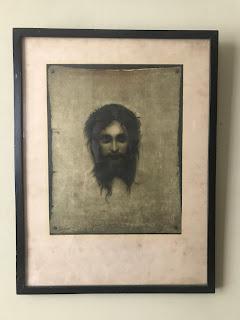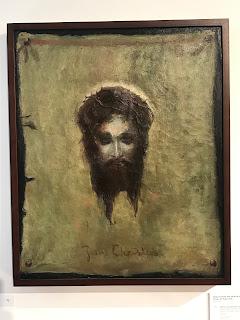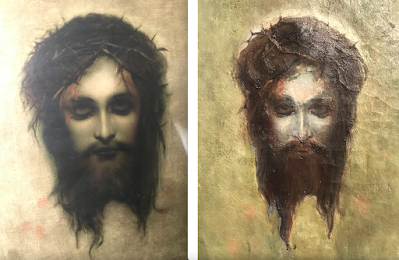 A couple of weeks ago I bought this old framed print “Jesus Christus” from a local second hand shop. It's behind glass and hard to photograph. Even though I’m an atheist, I'm a sucker for a beautiful religious piece, and I was drawn to this dark brooding version of Christ. I immediately hung it the wall when I got home that day.
A couple of weeks ago I bought this old framed print “Jesus Christus” from a local second hand shop. It's behind glass and hard to photograph. Even though I’m an atheist, I'm a sucker for a beautiful religious piece, and I was drawn to this dark brooding version of Christ. I immediately hung it the wall when I got home that day. Ten days later, yesterday, walking down Duke Street, St James's, heading to Christie’s to see the latest auction (wow! fab). This street offers a view into some of the sale rooms. I stopped in my tracks when I saw what I assumed to be the original painting of my new Jesus acquisition! We whizzed inside and discovered the painting is by Rene Magritte, completed in 1918 when he was only 20 years old, long before he was seduced by surrealism (theres's a lot of that stuff in the other rooms).
 It’s a beautiful painting, signed clearly by the Magritte at top right. Hmm, I thought, I don’t recall seeing that sig on my print. And then I noticed other things about that didn’t seem ‘right’ as I was sure my print was of a painting that was more delicate/fine. I took some photos and decided to delve further at a later date.
It’s a beautiful painting, signed clearly by the Magritte at top right. Hmm, I thought, I don’t recall seeing that sig on my print. And then I noticed other things about that didn’t seem ‘right’ as I was sure my print was of a painting that was more delicate/fine. I took some photos and decided to delve further at a later date.
When I got home, I studied my print and discovered it’s not the same work. A bit of quick online research makes it clear that Magritte's work is a copy of an 1885 painting by Gabriel von Max, his version of The Veil of Veronica.
Indeed, I looked at my snap of the Christie's info card at the side of the Magritte work and noticed that it does indeed show 'After Gab Max' on it – that hadn't meant anything to me at the time.
Max's art was popular during his lifetime and his image of Jesus quickly became available as lithographic prints, such as mine. He appears to have been a rather interesting man – amongst other things, he kept a ‘herd of monkeys’ in his garden house!
As these comparisons show (not taken at the exact same angle), Max's 1885 painting (L) and Magritte's 1918 painting (R) differ in many places:
Magritte’s version is more about the paint, which I love. Well, I love them both. Although Magritte has taken pains to copy some of Max's delicate red marks, he loses subtlety in the face especially around the eyes (which can be viewed as open or closed). Magritte has also enhanced the edges of the cloth (a fabrication by Max) and altered the position of the title at the bottom (see the framed versions above). And the signature – on close inspection, I can see on my print that there is a hint of a signature at top left (not visible here) that Magritte has chosen to replace with his own.
It's all a lovely coincidence, seeing as I had no idea about this image until ten days ago and would have been entranced by the Magritte version had I never see the Max one. I am now buzzing with questions:
Why did Magritte paint a copy of another man’s painting? Was it simply a training piece?
Where was Max's painting hanging at that time? Is that where Magritte made the copy? Or did he copy one of the many lithographic copies?
What other paintings did Magritte copy at this time?
Would Magritte's painting be worth Christie's estimated auction price of £70-100K had not later become famous for gravity-defying apples and pipes?
In comparison, how much is Max’s painting today? And where is it?
Christie’s sale rooms are always worth visiting. Ditto all other auction rooms. They are free to view and often it’s the only way to see beautiful works that will end up in private collections.
